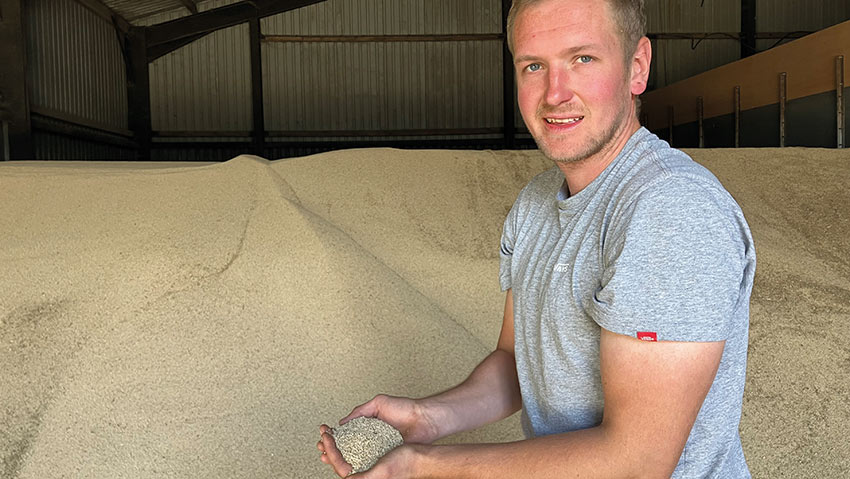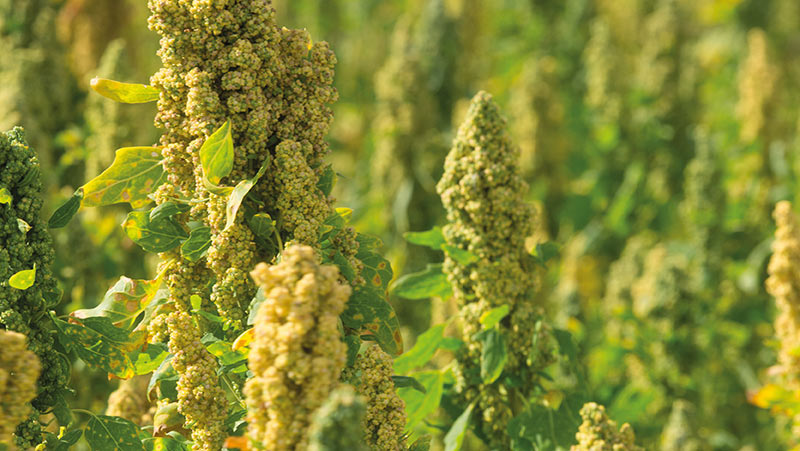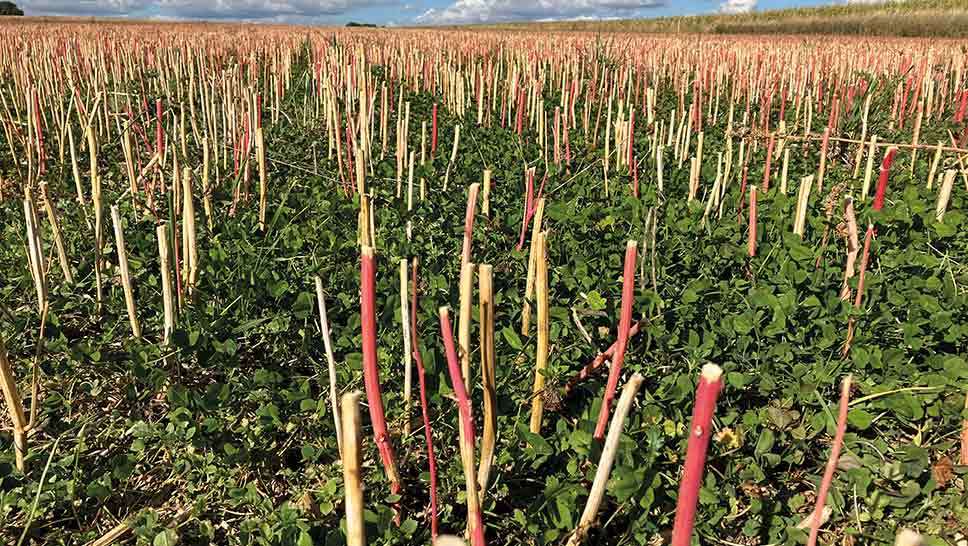British quinoa growers wanted as crop demand rises
 Joe Fisher © MAG/Emma Gillbard
Joe Fisher © MAG/Emma Gillbard The British Quinoa Company is searching for additional growers to expand its niche crop area next spring, driven by growing demand within the human consumption market.
Quinoa is a spring-sown pseudo cereal, meaning the crop is classed as a seed rather than a grain. It is relatively cheap to grow, with no insecticides, herbicides or fungicides approved for use, leaving nitrogen as its main input cost.
With a price of £900/t and average yields of 1.5-1.75t/ha, it offers competitive gross margins compared with other spring crops and could be a viable option as growers look to widen their rotation and reduce inputs.
See also: How OSR growers are affected by Ukraine war and politics
Upping supply
Contracts are offered on a buy-back arrangement with the seed supplied. The final crop is destined for human consumption, predominantly sold to retail packers or the food manufacturing industry.
About 300ha of the crop is grown in the UK at present among 12 growers, but the company hopes to expand this to nearer 400ha for harvest 2023.
Nottinghamshire arable farmer Joe Fisher has seven years’ experience growing quinoa, and offers his top tips for those considering growing the crop.
“Quinoa is a specialist crop and, therefore, requires attention to detail. Despite this, it can be grown successfully with the right approach and does not require specific machinery,” he says.
Establishment
The crop is usually drilled from late March to April, at a shallow depth of 1-2cm when soils are warming up. Establishment is particularly moisture dependent, so deeper drilling may be required when this is a limiting factor.
Quinoa tends to thrive on light-to-medium soils, rather than on heavier ground.
“The crop can be trickier to establish than standard cereals and certainly entails more risk, so getting it off to a good start with a good seed-bed is really important.
Fine-tuning according to the season is important as there is no absolute blueprint – I’ve had areas fail where I haven’t managed seed-bed conditions well,” he says.
Being a spring-sown crop, Mr Fisher uses his Claydon to direct-drill straight into a cover crop mix which is previously grazed-off by sheep.
He has direct-drilled all combinable crops for six years, but notes quinoa can perform better with cultivations to allow greater tilth and seed-to-soil contact.
Mr Fisher has just sent his 2022 crop to be cleaned, with yields averaging 2.1t/ha pre-cleaning.
In his first season growing the crop, a bumper harvest of 3t/ha clean weight was achieved when using a Sumo Trio and Vaderstadt drill.
Since the move to direct drilling, quinoa yields have declined, but he is planning to be more pragmatic about targeting cultivations.
Initially growing 14ha of quinoa, nearly 60ha of the crop is now grown. He advises farmers thinking of growing quinoa to plant a 15ha minimum to ensure its viability.
For those intending to drill direct into cover crops, he also ensures covers are completely destroyed in good time ahead of drilling, to avoid any allelopathic effects from the covers which can otherwise lock-up nutrients and negatively affect seedling emergence.
To this end, Mr Fisher grazes his cover mix of phacelia, linseed, forage raddish, stubble turnips, lupins, vetch and buckwheat with 200 sheep, before spraying with glyphosate.

© Tim Scrivener
Low input crop
The crop is very low input, with no pesticides approved for use. Therefore, successful growth revolves around a good seed-bed and reducing risk to get crops off to a good start.
“At stem extension, crops grow rapidly and can outcompete weeds, so getting them to this point as fast as possible is key.
“Avoiding weedy fields, particularly those prone to attacks of fat hen and blackgrass is important due to no in-field control available, with the exception of inter-row weeding.”
The main disease threat is downy mildew, which can attack crops early in the season, but the application of phosphorus micronutrient sprays provide a successful way to improve crop health and avoid disease build-up.
Nutrition
Anywhere between 80-120kg N/ha is recommended as the crop responds well to nitrogen. Last year, Mr Fisher applied 110kg N/ha, but he plans to scale this back.
He splits the application into two, with half of the nitrogen applied to the seed-bed with the drill and the remainder applied in liquid form when the canopy is in full.
Phosphorus, magnesium and manganese is always provided in his nutrition programme, applied shortly before stem extension.
“Depending on the season and crop potential, another application of micro-nutrients is applied during seed set in June and July.”
Harvest
Harvest normally takes place during September, using adjusted combine settings similar to that of cutting oilseed rape, with a higher knife setting.
This year, Mr Fisher grew three different varieties. The first is an early maturing variety called Bastille which almost guarantees a harvest in August, typically giving the best combining window.
He also grows new variety G16 and mainstay option Duchess.
The crop is sold in clean weight as up to 20-30% of the initial sample is removed due to impurities. It is cleaned up to 99.9% purity for the human consumption market.
Grains are typically mature before the stems, so harvesting between 15-20% moisture is common.
Drying the grain down to 11% and below for safe storage is important and requires an additional heating element to help the drying process.
“As the crop is sold as gluten free, segregating it from other cereals in storage is required.
“Quinoa is then stored on farm before being taken to the cleaning processor, at which point it is bought on a clean weight basis by The British Quinoa Company.”
For more information on growing the crop and getting a contract, contact Joe Fisher at joe@j-wkfisher.co.uk.
Other benefits
Quinoa also provides a range of environmental benefits, acting as an excellent habitat and food source for a number of bird species.
“The canopy is usually full of swallows and it also qualifies as a low input cereal crop (AB14) as part of the countryside stewardship scheme which pays £236/ha – which is a helpful addition, in recognition of its environmental credentials,” says Joe Fisher.
Undersowing quinoa with a clover living mulch

© MAG/Emma Gillbard
Joe Fisher successfully trialled undersowing a 12ha area of his quinoa crop with a clover living mulch last season in a bid to reduce N applications and suppress weeds.
Small leaf white clover was spun on with a slug pelleter shortly after drilling.
With the crop now harvested, a layer of clover remains which will be direct-drilled with winter wheat.
However, establishment was patchy, which is why he intends to increase application precision by drilling the clover seed between the quinoa rows next season.

